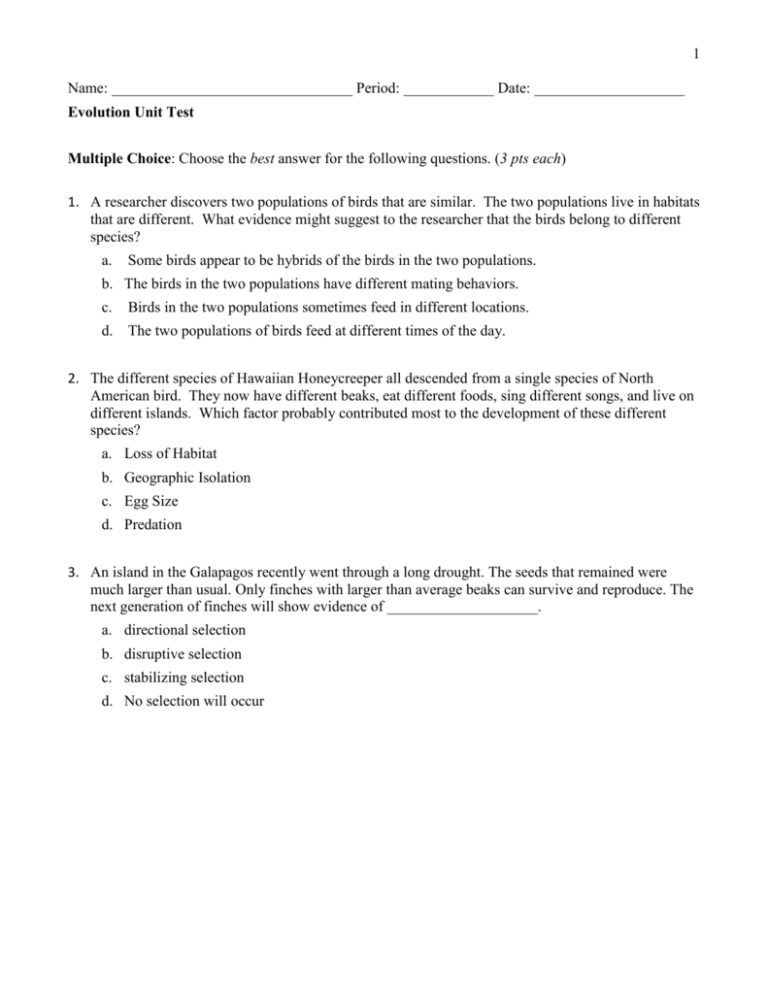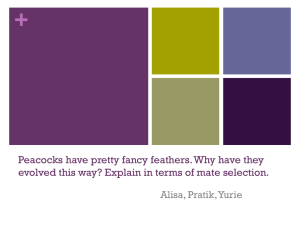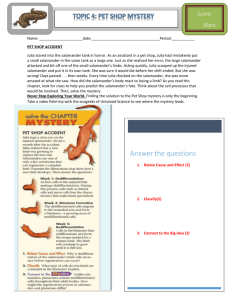Evolution Test and Answer Key
advertisement

1 Name: ________________________________ Period: ____________ Date: ____________________ Evolution Unit Test Multiple Choice: Choose the best answer for the following questions. (3 pts each) 1. A researcher discovers two populations of birds that are similar. The two populations live in habitats that are different. What evidence might suggest to the researcher that the birds belong to different species? a. Some birds appear to be hybrids of the birds in the two populations. b. The birds in the two populations have different mating behaviors. c. Birds in the two populations sometimes feed in different locations. d. The two populations of birds feed at different times of the day. 2. The different species of Hawaiian Honeycreeper all descended from a single species of North American bird. They now have different beaks, eat different foods, sing different songs, and live on different islands. Which factor probably contributed most to the development of these different species? a. Loss of Habitat b. Geographic Isolation c. Egg Size d. Predation 3. An island in the Galapagos recently went through a long drought. The seeds that remained were much larger than usual. Only finches with larger than average beaks can survive and reproduce. The next generation of finches will show evidence of ____________________. a. directional selection b. disruptive selection c. stabilizing selection d. No selection will occur 2 4. Which statement is best supported by the phylogenetic tree shown? a. Species V is still alive and is the oldest species. b. Species W is still developing from a prior species. c. Species X,Y, and Z became extinct 20 million years ago. d. Species W first came into existence 10 million years ago. 5. A fossil was recently discovered on the boundary between two rock layers. The lower rock layer formed between 10-11 million years ago. The upper rock layer formed between 9-10 million years ago. From this, scientists infer that the fossil is between 9-11 million years old. This method of dating is known as: a. Absolute dating b. Layer dating c. Radioactive dating d. Relative dating 6. The bones that make up the forelimbs of monkeys, cats, whales, and birds are similar. Which of the following statements best supports the evolutionary relationship of these animals? a. The animals have different ancestries but have adapted to similar environments. b. The animals share a common ancestry but have adapted to different environments. c. The animals at one time lived in different environments but now share an environment. d. The animals use their forelimbs for identical activities but live in different environments. 3 7. Some snake embryos have small buds resembling limbs. These buds disappear at later stages of embryo development. These findings suggest that these snakes. a. Had a parent with limbs b. Have functional limbs as adults c. Will have offspring with limbs d. Evolved from an ancestor that had limbs 8. Which of the following is evidence to support the idea that two different species might have a common ancestor? a. Their fossils were discovered in the same location. b. Many of their genes are the same. c. Their methods of respiration are alike. d. They use the same means of locomotion. 9. Bacteria adapt more quickly than elephants to environmental changes. Which best explains this difference? a. Bacteria reproduce more rapidly. b. Individual bacteria grow more steadily. c. Bacterial populations are more isolated. d. Individual bacteria have more genes. 10. The eastern meadowlark and the western meadowlark are two closely related bird species. The two species avoid interbreeding because they have different mating songs. This is an example of: a. adaptive radiation b. behavioral isolation c. geographic isolation d. artificial selection 11. Which of the following factors is NOT necessary for natural selection to occur in a population? a. Advantageous traits b. Heritability c. Variation d. Random mating 4 12. Some areas of a forest contain rich soil, while in other areas the soil is poor. Plants of a certain species grow taller in the rich soil than in the poor soil. The taller plants receive more sunlight and are able to produce more offspring than the shorter plants. If these offspring grow in rich soil, they are tall, but if they grow in poor soil, they are short. Which of the following statements best explains why this situation is not an example of evolution by natural selection? a. The observed differences in plant height are not due to genetics. b. The differences in soil conditions do not affect all plants equally. c. The short plants and tall plants are not isolated enough from each other. d. The short plants are not accumulating gene mutations as quickly as the tall plants. Amino Acid Differences Compared with Human Protein A Species Number of amino acid differences Dog 41 Gibbon 12 Trout 130 Whale 15 13. According to the chart, which of the following species is most closely related to humans? a. Dog b. Gibbon c. Trout d. Whale 5 Salamander Identification Key 1a. Hind legs absent (2 legs) ................................................................................................................. Siren 1b. Hind limbs present (4 legs) .................................................................................................. go to step 2 2a. Body background black ....................................................................................................... go to step 3 2b. Body background white ....................................................................................................... go to step 4 3a. Small spots lined up in two rows ........................................................................... Jefferson salamander 3b. Spots scattered over body ........................................................................................... Tiger salamander 4a. Large spots on body ................................................................................................ Marbled salamander 4b. Stripe running up back ..........................................................................................Four-toed salamander 14. Use the key above to identify the salamander shown. Which species is the best match for the pictured salamander? a. Four-toed salamander b. Jefferson salamander c. Marbled salamander d. Tiger salamander 6 15. Based on the information given in the chart above, which insect is most closely related to the Curculio rectus (Oak Weevil)? a. Mullein Weevil (Gymnetron tetrum) b. Hazelnut Weevil (Curculio neocorylus) c. Pine Reproduction Weevil (Cylindrocopturus eatoni) d. Boll Weevil (Anthonomus grandus) 16. Suppose a storm kills 70% of the rabbits in a population. Will the remaining rabbit population be more or less likely to survive an infection of influenza than the original population? a. The new population will be more likely survive because the remaining rabbits are stronger. b. The new population will be more likely to survive because there will be more food available per rabbit. c. The new population will be less likely to survive because there is less genetic variation among the rabbits. d. The new population will be less likely to survive because the storm weakened the rabbits’ immune systems. 17. Carbon-14 has a half-life of about 5,000 years. Scientists determine that a recently discovered fossil has about one half (50%) of the original amount of carbon-14. How old is this fossil? a. 1,200 years b. 2,500 years c. 5,000 years d. 10,000 years 7 18. The method of dating fossils described above is known as ______________________. a. Absolute dating b. Isotope dating c. Relative dating d. Sedimentary dating Use the cladogram below to answer questions 19 and 20 19. Which of the following characteristics is a derived trait of mammals (the mouse and chimp)? a. Jaws b. Lungs c. Claws or nails d. Fur; mammary glands 20. Which of the following two animals are most closely related according to the cladogram? a. Hagfish and chimp b. Hagfish and perch c. Pigeon and chimp d. Pigeon and lizard 21. A set of fossils is found that shows the change of an ancestral horse to a modern one. Many transitional forms are found that show the slow change from the ancestor to modern horse. Which of the following patterns of evolution does this set of fossils support the most? a. Convergent Evolution b. Divergent Evolution c. Gradualism d. Punctuated Equilibrium 8 22. When he traveled to the Galapagos, Charles Darwin observed several species of finches that resembled one another. He concluded that these species had a common ancestor and had changed over time to best survive in their environment. What did he call this theory? a. Theory of acquired characteristics b. Theory of descent with modification c. Theory of inherited d. Theory of natural selection 23. The wing of a butterfly, the wing of a bat, and the wing of a bird are all adapted to flying. Each wing has a different bone structure and they appear to have evolved independently from one another. These structures evolved by _________________ evolution and the structures are _______________. a. Convergent evolution; analogous structures b. Convergent evolution; homologous structures c. Divergent evolution; analogous structures d. Divergent evolution; homologous structures 24. The above image shows embryos very early in the development of several vertebrate animals. Which of the following does this best show? a. A bird is more closely related to a mammal than a reptile b. Amphibian, reptile, bird, and mammal embryos develop for the same amount of time c. Amphibians, reptiles, birds, and mammals share a common ancestor d. Amphibians, reptiles, birds, and mammals have adapted to a similar habitat 9 Short Answer: Read and follow the directions for the following questions carefully. (9 pts each) 25. Researchers have discovered two salamanders while exploring a local stream. They are unsure of whether the two salamanders are separate species or members of the same species. a. State the biological species definition: b. Briefly describe how the researchers could test if these salamanders are different or the same species (think about the definition above): c. Identify two problems with this definition of species: 26. Lamarck is well-known for his Theory of Acquired Characteristics and Darwin is famous for his Theory of Natural Selection. Compare and contrast these two theories. a. State two similarities: b. State two key differences: c. Which theory is currently accepted? Give at least one piece of evidence that supports that theory. 10 27. Male peacocks have long colorful tail feathers. There is variation in the size and brightness of the tail. Scientists observed the mating success of two categories of peacocks. The data is shown in the graph below. a. Explain what the graph shows about the relative mating success of each category of peacock. b. Identify one disadvantage that longer, more colorful tails might have for peacocks. c. Many male peacocks have long, colorful tails. Explain why so many male peacocks have evolved longer, more colorful tails even though this type of tail causes some disadvantages. (Include the effects of the trait on the peacocks’ survival and on their reproduction.) 11 Answer Key 1. B 2. B 3. A 4. A 5. D 6. B 7. D 8. B 9. A 10. B 11. D 12. A 13. B 14. D 15. B 16. C 17. C 18. A 19. D 20. C 21. C 22. D 23. A 24. C 25. a. Student correctly states biological species definition (a group of organism that can interbreed in nature) b. Student proposed reasonable experiment that relates to the definition (test in lab if the specimens can breed, observe if the specimens breed in the wild, etc.) c. Student identifies one valid problem with the definition of species (Not always possible to observe mating in the wild, Some species can produce hybrids, Doesn’t work for asexually reproducing organisms, others will be considered) 26. a. Similarities (states that two all life evolved from common ancestors, life has changed over time, explain how life is adapted to environment) b. Differences (Darwin: populations change, variation that is inherited, different survival and reproduction, Lamarck: organisms pass on traits acquired during lifetime, use and disuse, progress of ladder) c. Theory of Natural Selection (Mendels discovery of genes, fossils showing change over time, observing evolution in Galapagos, etc.) 27. a. Peacocks with longer, more colorful tails have more mating success b. Longer, more colorful tails make peacocks more vulnerable to predators, take more resources to develop, other answers may be accepted c. Even though long colorful tails are a disadvantage for survival, they attract females and improve mating success. These peacocks have more offspring which will also have long colorful peacock tails. This is called sexual selection (not necessary for credit).








